
The identity of a people from closed and inward-looking societies are severely limited. Products of such societies are also inward-looking.
What does it mean to be closed and inward-looking? Here’s a reproduction from the blog post Open Societies Use Information & Knowledge To Free Their People; Closed Ones to Control.
Being closed as an individual means having — and believing in — a narrowly defined identity mostly for lack of knowledge and understanding about not just other people of different culture, nationality, etc. but also for lack of knowledge and understanding about themselves as human beings. Closed people have an unhealthily strong and intimate attachments to — and invest a lot of time and energy in “protecting” — that which is associated with their limited identity, notably their ethnicity, caste, race, gender, sex, or sexuality, culture, religion, or nationality etc.
Lacking in any significant knowledge and understanding of and experience with others — people of different culture, religion, sexuality, nationality etc. — closed people are inward-looking. They over-inflate the value their culture, their religion, their beliefs, their practices etc. They rely on them — or use them — to explain life and the world. They use them to guide not only their practices but also major life choices and decisions. Science does NOT play anywhere near as big a role as religion does in them.
Many societies around the world produce closed and inward-looking people. As a matter of fact, every society, because of its very nature, produces such individuals — the difference between societies being in the level and extent, and the percentage of such individuals they produce. Truly open and outward-looking societies, those at the other end of the spectrum, are in the minority.
Nepal is a closed and inward-looking society and therefore produces a majority of such individuals. Most Nepalis define themselves by their Nepali nationality and symbols associated with the country — such as triangular flag, the national animal (the cow), the national language (Nepali) etc. They define themselves by their religion (Hinduism and to some extent Buddhism). The history of the brave of warriors and rulers of the past, mostly belonging to the Hill so-called High Caste, are also part of their identity. A majority display, demonstrate, and express intimate ties with and connections to those elements of their identity, and the elements, in turn, to themselves, as if inalienable.
The high level of religiosity and the low level — of poor quality — of education of the population, among other things, reinforce, sustain, and perpetuate that.
Worse, they are raised and educated to be — and are — proud of the elements of their identity! I know because I was when I was a student. Glorified and elevated by the education in schools, by traditional culture, and society at large, they are proud of fact about the country. One such fact is Buddha being born here. They are also proud of Nepal being the country of Mount Everest. There are those who are even proud of their caste, proud of their religion and being a follower of it, proud of their festivals, proud of the country’s history, and even proud of their gender etc. Not surprisingly, you don’t often come across many who question any of that — even as adults.
Few are taught and fewer even learn that those elements of their identity are things that they were just born into. They are also NOT taught that all of them are external to them, and, most importantly, just social constructs. That is, they are not taught that their values and meanings are based on things outside of their person, or are based — or depends — on sufficient people collectively recognizing, accepting, and believing in them. Those values and meanings do NOT exist independently of the people who accept — or believe in — them.
What’s the worst however is that, being proud of the narrow and exclusive (as opposed to broad or expansive and inclusive) identity, they feel the need to “defend” and “protect” it. I suppose, they likely believe that, if they don’t, their person-hood will be reduced to something much smaller than their own over-inflated perception of it!
So naturally, to begin with, they are “offended” or “hurt” by anything they perceive as an attack on or a criticism of their identity, or aspects thereof. When they come across that, their knee-jerk reaction is to lash out, to go on the offensive. The sensible reaction would be to take a few steps back and introspect but they don’t — in most cases likely because they are incapable of doing so.
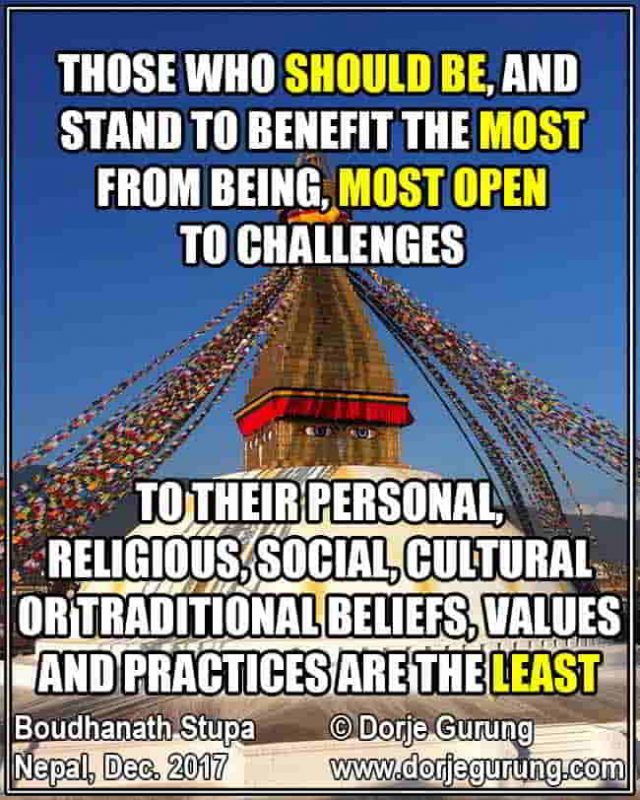
One of the many things many Nepalis are “hurt” by is any perceived attack on — or an aspect of — Hinduism, for example. Another one Nepalis struggle to swallow readily is a critical analysis of our “glorious” (casteist!) history! Still another is the biggest (Hindu) national festival: Dassain.
The festival, however, has a dark side to it, one of which I detailed in part one of this series. The blog was based on the content of the article Setopati attached in the tweet below. The article details the history of what Dassain symbolized for the Limbus, an ethnic group indigenous to the North-Eastern Nepal.
लिम्बू र किराँतीहरूलाई यसरी बाध्य पारियो दसैं मनाउन
— Setopati (@setopati) October 13, 2021
By-@prachin03https://t.co/vVm1N35s1l
So what do closed and inward-looking Nepalis do when the dark history of Dassain is exposed and/or when fellow Nepalis protest against the festival? They don’t understand it and vehemently object, of course! And worse, they don’t WANT to understand, sadly!
What follows are just a few sample objections. The following two are attacks directed at the history, that is, the content of the article.
The following hill so-called High Caste Hindu man declares, in the first sentence, “This history is just a load of bull.”

The following user blows off the history saying, in the first sentence, “…hearsay, word-of-mouth stories, concocted stories etc.”!

The following two are examples of attacks directed at the editor and/or the paper. Yes, they attacked the editor!!
Many of them gave, to the editor, the epithet “dollar-farmer.” The term is supposed to be pejorative, denoting someone who panders to foreign donors (for their dollars) and advances narratives and agenda advocating for the rights of women, the marginalized etc. with the intention of dividing the people and disrupting social harmony etc.
In the following (see below), by a hill so-called High Caste Hindu man, says, “…dollars have arrived for [editor] Ameet brother” among other things. He concludes, “This is about caste. If convenient, publish articles about the sufferings of our sisters and about animal rights as well.”
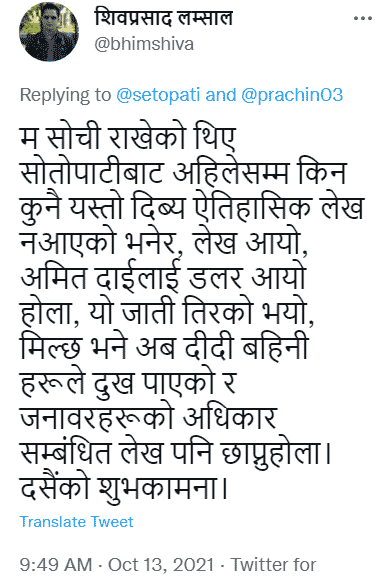
Another so-called High Caste Hindu man declares, “When you are dollar sponsored you have to publish these kinds of articles, please understand.”

Of course, if you really think about it, if you introspect, the country of Nepal itself is a “dollar farmer” given how much we have always relied and continue to rely on foreign donations, grants, loans, and remittance from abroad. But that inconvenient truth is either likely lost on them or, if they are aware, they’d rather live in denial of — something Nepalis in general are really good at.
The following set are a few examples of those that are just plain dumb.
The one below also by a hill so-called High Caste Hindu man assumes ulterior motive behind the publication. Says, “Our so-called respectable media are driven to create division [between people][.] Hard to tell if they are involved in missionary work or journalism.”

The following, also by a hill so-called High Caste Hindu man states, “Materials to break the existing harmony between us[.] Talk of these kind of things and Christians will lure people into engaging in religious attacks.”

Closed, inward-looking, and very thin-skinned Nepalis, I have discovered, are very concerned about that which they feel is divisive or that which threaten our social harmony, not surprisingly! As a matter of fact, in tweets I have made on issues such as this, I have made a point of pre-empting such responses, as you shall see in one of my tweets reproduced farther down below.
The one below, also by a hill so-called High Caste Hindu man, asks, “Again, who is this nincompoop opposed to celebrating Dassain?” He wrap up with some colorful words. “Just don’t celebrate, sh*t head! Celebrate Christmas singing songs of Limbhuwan f*cker!”

The following one asks, “Brother, is there any truth to the content of this article or are they just fulfilling their duty??”

The following so-called High Caste Hindu man mockingly says, “What unfortunate fate or chaos did you have to suffer from celebrating Dassain[?]”

The following, in English is so dumb that it makes no sense whatsoever. No clue how that is in anyway any kind of a rebuttle of any argument in the article, or an objection to the subject of the article etc.

Under the tweet are almost four-dozen responses and a majority are along the same veins. If interested, just follow the link to the tweet.
Once again, many of those objecting to people protesting Dassain, being closed and inward-looking, are pretty clueless and, in essence, exposing their ignorance of the fact that Dassain is a symbol of oppression and suppression, among other things.
Of course, it might NOT surprise you to know that Nepali twitter users attacking Dassain protesters or expressing incredulity at the latter can also be found elsewhere.
This tweet innocently asks, “I can’t believe that now people have an issue with Dashain?”
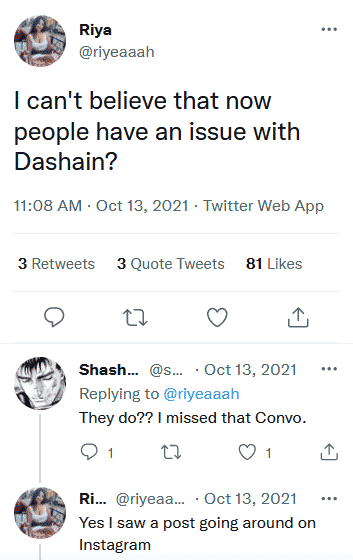
And, adding his voice to that, a hill so-called High Caste Hindu man (Dipak Uprety) exposes his own ignorance by writing off those protesting against the festival as “uneducated.”
He says, “It’s become a habit of Nepalis to protest for the sake of protesting without knowledge and understanding. This is likely the result of our non-contextual and impractical education (which makes our students literate but not educated) and NGO/INGO.”

NGOs/INGOs are two prominent punching bags of the nationalists and ultranationalist Nepalis! It is true that the quality of our education is abysmally poor but it’s also true, of course, that we need to revise the narrative that has been taught to us about Dassain.
Reproduced below is the original tweet and a very good response to it by a Hill so-called High Caste Hindu woman but it seems to have been ignored.

Here’s another response also by a Hill so-called High Caste Hindu woman which, again, tries to educate Riya. However, she did NOT acknowledge this one either.
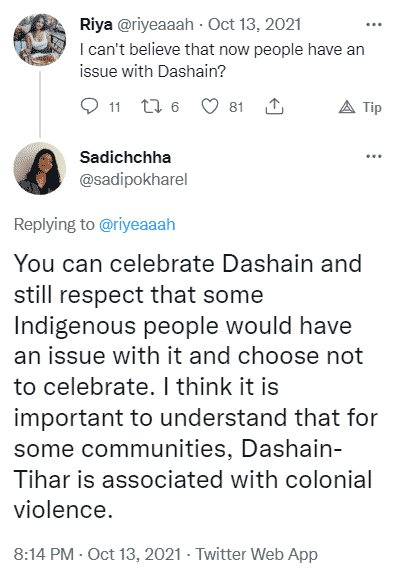
Another user, Ankit (see below) tried to explain it saying, “Yes, because for many indigenous people Dashain was something they were forced to celebrate.” But, still, Riya didn’t get it and, instead, came back with a farcical retort: “How is that Dashain’s fault?”

Ankit tries again. Riya didn’t respond but another user did expressing his lack of knowledge on the subject.

And so I gave it a try.
Some more stories of oppression carried out by the Hindu rulers using Dassain that our education system never taught us.
— Dorje Gurung, ScD (h.c.) (@Dorje_sDooing) October 14, 2021
So, Dassain, being a festival & not a human agent, is not at fault. But it is a symbol of the oppression many people suffered from. https://t.co/BCbTPhZrpP
But ofc, Nepalis being Nepalis,
— Dorje Gurung, ScD (h.c.) (@Dorje_sDooing) October 14, 2021
they take that personally, feel “hurt”,
& refuse to be educated about elements
of history they were never taught or
exposed to but others had to suffer for
GENERATIONS silently & are still suffering
from, albeit not as much as their ancestors.
In the 30-yr history of democratic#Nepal, there’s been NO violence of
— Dorje Gurung, ScD (h.c.) (@Dorje_sDooing) October 14, 2021
real note against d State or society
by non-Khas-aryas in spite of
generations of oppression
& suppression by d past Hindu
Society & State. D ONLY violent
uprising AGAINST it was lead by 2
Brahmins.
The two Brahmins are no other than Puspa Kamal Dahal (“Prachanda”) and Baburam Bhattarai. What I referred to as the “violent uprising” was actually a ten-year civil war from 1996 to 2006!
Sadly, many more who engaged with the original tweet agree with it or question the objections to and protests against Dassain.
In a closed and inward-looking society of Nepal, where over 80% are Hindus (see below), of course protests against that which is touted as the biggest festival of the country many will and do take it as an attack on their identity.
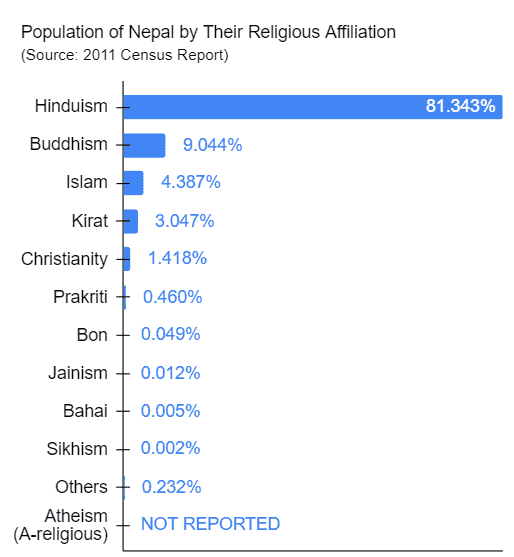
That is a little a too much for them to handle, not surprisingly!
What do you think?
* * * * * * * *
Additional Materials
- Untold History of Dassain, A Symbol of Oppression and Suppression
- If protests against Dassain hurt your sentiments…
- Dassain: Traffic, Goats, Sheep, Chickens and a Trek
- Like Gods, Like Humans? Or, Like Humans, Like Gods? Or, Like…F*cked up?

We should start questioning brahminism, which upholds casteism, and many caste oppressors won’t question them because it supports their ideologies, which include patriarchy, caste discrimination, and many more. Also, please refrain from using high-caste and low-caste because it uplifts the hierarchies that are aiming to keep casteism intact. Even in India, many caste-oppressed people are rising up against brahminism and have been making parties to solely focus on abolishing brahminism.
Dear Angana,
To begin with thank you for your comment.
And yes I agree with you wholeheartedly on the need to question Brahminism (Bahunbaad) in Nepal.
As for using “high-caste” and “low-caste”, again I wholeheartedly agree with you on the need to refrain from using them because of how they inadvertently reinforce and help maintain everything they denote and connote, including the hierarchies, and help maintain casteism. That is PRECISELY why I have qualified every use of those terms with “so-called,” which is one of the standard and accepted way to fight it. I should, however, thank you for pointing that because I noticed two incidences of “high caste” in this blog which had NOT been qualified with “so-called”. I have corrected that.
Once again, thank you for your comment.